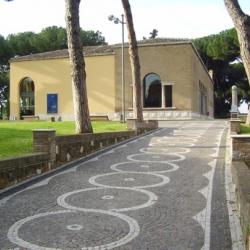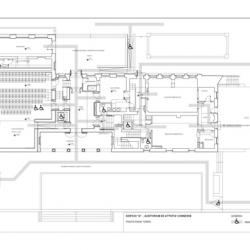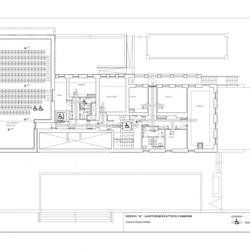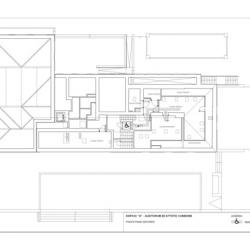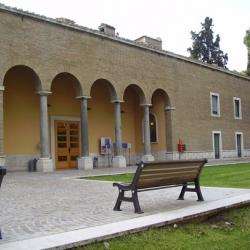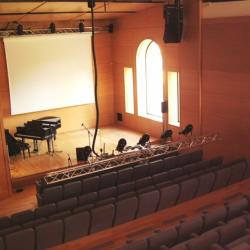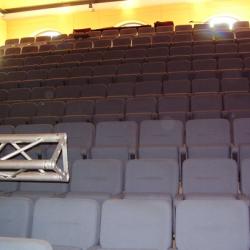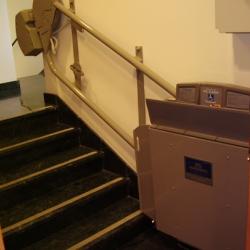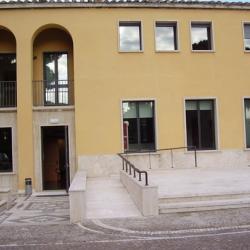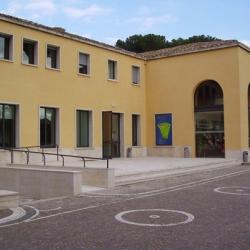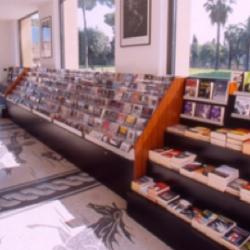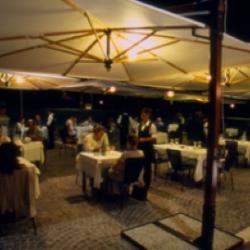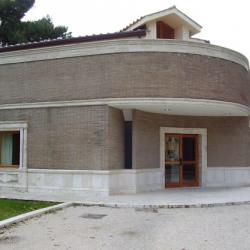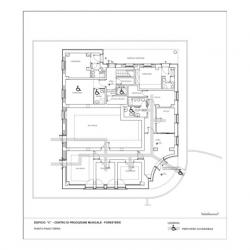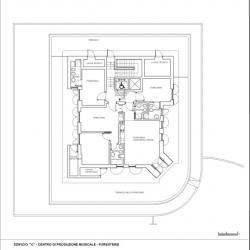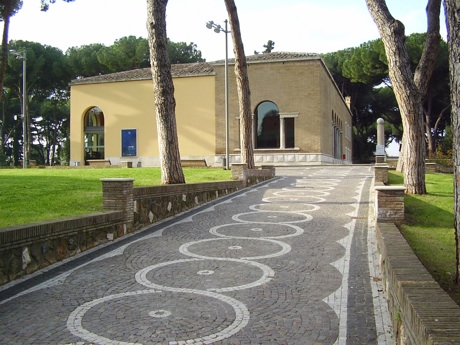
Introduction
The New York Times reported on the dramatic opening in Central Rome of Casa Del Jazz in 2005 on April 21, Rome’s 2,758th birthday. The transformed estate on Via di Porta Adeatina, once owned by Enrico Nicolletti, an alleged Mafia boss, sits in the midst of dense pine trees near the Aurelian Wall. Mayor and jazz lover Walter Ventroni personally pushed for funding for this adaptive reuse renovation that restored an important, if somewhat infamous property, to public use.
The grounds of the park were refurbished as well as a primary structure as well as two smaller buildings. Within 27,000 square feet [2,500 square meters] there’s a 150-seat concert hall, a library, a recording and rehearsal studios, a restaurant, a book and record shop, administrative offices and sleeping quarters for musicians. Casa Del Jazz was renovated to ensure that performers, visitors and staff are able to use the various facilities easily, comfortably and without restriction or impediment.
Description
Casa del Jazz was the former estate of a prominent figure in the Roman crime world. Eventually confiscated by the government, the city of Rome entrusted the mansion (1200 square meters over three floors), two smaller buildings, and 25,240 square meters [6.281 acres] of greenery to the Zetema Culture Project, who was responsible for the renovation. The facilities are now owned by Azienda Speciale Palaexpo, an influential organization for the arts controlled by the City of Rome.
Casa del Jazz is located near the Sangallo Fort, with the ruins of Augusteo auditorium visible from the grounds and a number of archeological sites along the estate’s periphery. Prior to the 1930’s, the time of the mansion’s construction, new city planning concepts were being applied in Rome which resulted in demolishing some buildings and storing materials for future use. Some of these materials were used for the Casa del Jazz, allowing the mansion to follow the stylistic language of the neighborhood. The architect was Cesare Pascoletti.
Accessible on the first floor of the main building are the concert hall, bookshop, audio library, publication library, cafeteria and public toilets. Two large terraces on either side of the building extend the reception space. Upstairs are studios for recording, practicing, and auditioning. These are accessible to people who cannot climb the stairs via a lift.
The detached unit, considered the “Center for Music Production,” is located approximately 76.2 meters behind the main building. A narrow gravel road circulates throughout the estate and connects the buildings to one another. The road is wide enough for the passage of vehicles. Benches at intervals become a welcome resting place for walkers. Indoors, the center provides accommodations for rehearsal, classes, and lodging for visiting artists, including one accessible suite and ample community space.
Photos
Entrance to the Park
Photo Credit:
Main Building First Floor Plan
Main Building Second Floor Plan
Main Building Third Floor Plan
Entrance and patio
Photo Credit:
Concert Hall
Photo Credit:
Concert Hall from Stage
Photo Credit:
Stair Lift
Photo Credit:
Travertine Terrace Approach
Photo Credit:
Travertine Terrace
Photo Credit:
Dinner on the Patio
Center for Music Production Exterior
Photo Credit:
Center for Music Production First Floor Plan
Center for Music Production Second Floor Plan
Design and the User Experience
Most people reach the Jazz House by private car, as access from public transportation is difficult. The Azienda Speciale Palaexpo hopes that a planned shuttle service will offer an alternative to driving. They also plan a new signaling program that would enhance on-site wayfinding for users with visual impairments.
Within the main building, the bookstore, library, and multimedia archive have been designed to work well for diverse users. The bookstore’s long rectangular space offers a simple layout with display units running parallel on each wall. The shelves, all at a mid-range height and slightly recessed, hold books and music.
The multimedia archive and library have been designed to harmonize with the program of each space. In the library, users can settle around a large, central table, or one of the library’s reading chairs. The collection is displayed around the perimeter of the room behind glass, affording easy transitions between arrival, searching, and locating the desired publication. In the multimedia archive, there is a continuous work surface throughout the room for desktops computers, each of which link users to the database supported by Radio Televisione Italiana (RAI).
The concert hall contains 146 seats arranged over two terraced seating areas, as well as additional room for wheelchairs amongst the first two rows. Separating the two seating areas is a walkway, wide enough to serve as a break point for those ascending the steps to their seats. This tier is also used as a safety measure as it projects from one of the hall’s three exits.
In effort to create an acoustically balanced environment, the beach wood paneled walls and ceiling contain sound reflection properties. A state of the art audio system further perfects the audience’s experience, while also offering a level of versatility depending on the needs of both the artist and the listener. The superb acoustic environment is also serviceable towards the program’s desire to record and share performances.
Another architectural element enhanced by technology is lighting. As opposed to creating a closed environment within the concert hall in which illumination is exclusively controlled by lighting technicians, three windows tower over the stage on the southeast wall. The availability of the windows and natural light is not only visually pleasing, connecting the estate both indoors and out and complimenting the beach wood’s warm tones, but is also a desirable alternative to artificial stage lighting.
In the summertime, a series of performances are held outdoors. Though the layout of the performances is hardly impromptu in nature (a large stage, impressive audio system and intricate lighting display transform the estate), the free arrangement of outdoor seating on the lawn means some users may have difficulty moving over the landscape to their seat or seating location. This issue surfaces in other areas of the park as well, where fine gravel has been laid that may hinder movement for those with mobility concerns.
Evaluation
Casa del Jazz exemplifies the ways in which a design firm can go beyond code compliance to enhance user experience. There are instances in which universal access is treated in a way that recalls Pascoletti’s original design: a travertine ramp bringing users to the main entrance blends seamlessly with the terrace and front steps, for example. The curb ramps around the building are also materially seamless with the sidewalk. In this case, however, some sort of visual or tactile cue of the ramps’ location may be more desirable. While the granite ramp has a strong architectural presence, the subtleness of the curb ramp makes them more difficult to locate.
As a venue, the concert hall lends itself to performances that can be enjoyed by many, whether or not it be an auditory experience. Its scale preserves the intimacy of a coffee house while simultaneously providing concert-goers and musicians the technical advantages of professional performance venues. A more diverse array of seating opportunities for wheelchair users would be welcomed.
Transportation to and from the site will continue to be a concern until a shuttling service or alternative public transportation system is established. Without this type of accommodation, the organization’s mission to heighten public awareness of jazz can only be partially fulfilled.
Universal Design Features
- In many instances, accessibility is addressed in a manner that stylistically recalls the original architect, Cesare Pascoletti.
- The multimedia libraries and shop are intuitively laid out. Most of the collection faces forward on shelves that fall within appropriate reaching dimensions. From any one vantage point, the user is able to receive most, if not all, of the room’s spatial information, making them easy to navigate.
- In the concert hall, acoustic design ensures a high quality auditory experience for varying levels hearing abilities.
- Wayfinding in the main building is enhanced by signage as well as overlap of accessibility within existing, non-accessible spaces. Users requiring mechanical assistance ascending or descending stairs needn’t take an alternative route: stair lifts have been installed where there is less severe changes in floor height and staircases and elevators are located next to each other.
- Outside, users can follow clearly defined paths throughout the park that remain well lit at sundown. Plenty of benches are available as well.
Environmentally Sustainable Features
* Not available
Project Details
* Not available
Project Team
Client: Rome City Council
Project Manager: Guido Ingrao, Zetema Culture Project
Universal Design Consultant: Fabrizio Vescovo
Additional information
* Not available
Funding By


Propose a Case Study
Help us improve our Case Study library

